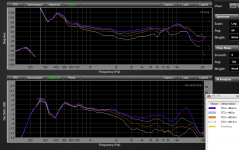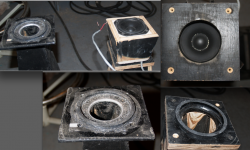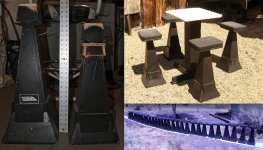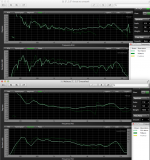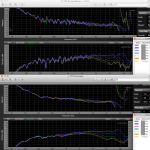xrk971,
Assuming Bushmeister is using the 18 Sound XR1464, the Faital Pro LH142 polars looks pretty similar,
Glad it's not just me confused between the similar model numbers in the 18sound range 🙂
That may be the price to pay for the lower frequency horn loading that they provide for 1.4in compression drivers?
I know what you mean when compared to a SEOS12 directivity map:

But, the tradeoff is that it is such a short horn (3.5in deep vs almost 9in), there won't be any horn gain at 500Hz to give the full range the sensitivity boost it needs.
I know what you mean when compared to a SEOS12 directivity map:

But, the tradeoff is that it is such a short horn (3.5in deep vs almost 9in), there won't be any horn gain at 500Hz to give the full range the sensitivity boost it needs.
Got the TC9 3.5" smooth by expanding the 2" throat to 2.5".Weltersys likes to see the magic smoke emitted from a 30w driver pushed to 800w for fun. It's ony $10 a pop so not a big deal I guess.
I wonder if the whole smooth throat and damping pad trick that Bushmeister did with the SB65 and a 1.4in throat can work on a 3.5in driver and a 2in throat?
Surprisingly, a 1/2" radius rounding of the throat entrance made virtually no difference, the charts are almost identical with or without.
Chart below is indoors, I think the dip around 390 Hz is an exaggerated room artifact, will do comparisons outdoors another day.
Lost a bit of the 500-2kHz sensitivity, but the Maltese is actually smooth enough now to use without EQ, with EQ should cover the decade from 200 to 20kHz. "0 dB" on the chart is around 94 dB sensitivity one watt one meter, a quad (40 x40 dispersion) will be 100dB, will do 120dB+ at rated power, 130+ if you keep an eye on the program material 😉 .
A damping circle on axis behind the grill cloth will smooth the 12.5kHz peak, though for my intended use (center fill for live music) will probably just EQ it down a bit, want all the sensitivity available.
Art
Attachments
Glad it's not just me confused between the similar model numbers in the 18sound range 🙂
I was wondering about that. Bushmeister is using the XT1464 elliptical 60x50 deg and plastic construction.
The XR1464 Weltersys mentioned is a square 60x40 deg and aluminum construction.
https://www.lautsprechershop.de/pdf/18s/18sound_xr1464.pdf
Got the TC9 3.5" smooth by expanding the 2" throat to 2.5".
Surprisingly, a 1/2" radius rounding of the throat entrance made virtually no difference, the charts are almost identical with or without.
Chart below is indoors, I think the dip around 390 Hz is an exaggerated room artifact, will do comparisons outdoors another day.
Lost a bit of the 500-2kHz sensitivity, but the Maltese is actually smooth enough now to use without EQ, with EQ should cover the decade from 200 to 20kHz. "0 dB" on the chart is around 94 dB sensitivity one watt one meter, a quad (40 x40 dispersion) will be 100dB, will do 120dB+ at rated power, 130+ if you keep an eye on the program material 😉 .
A damping circle on axis behind the grill cloth will smooth the 12.5kHz peak, though for my intended use (center fill for live music) will probably just EQ it down a bit, want all the sensitivity available.
Art
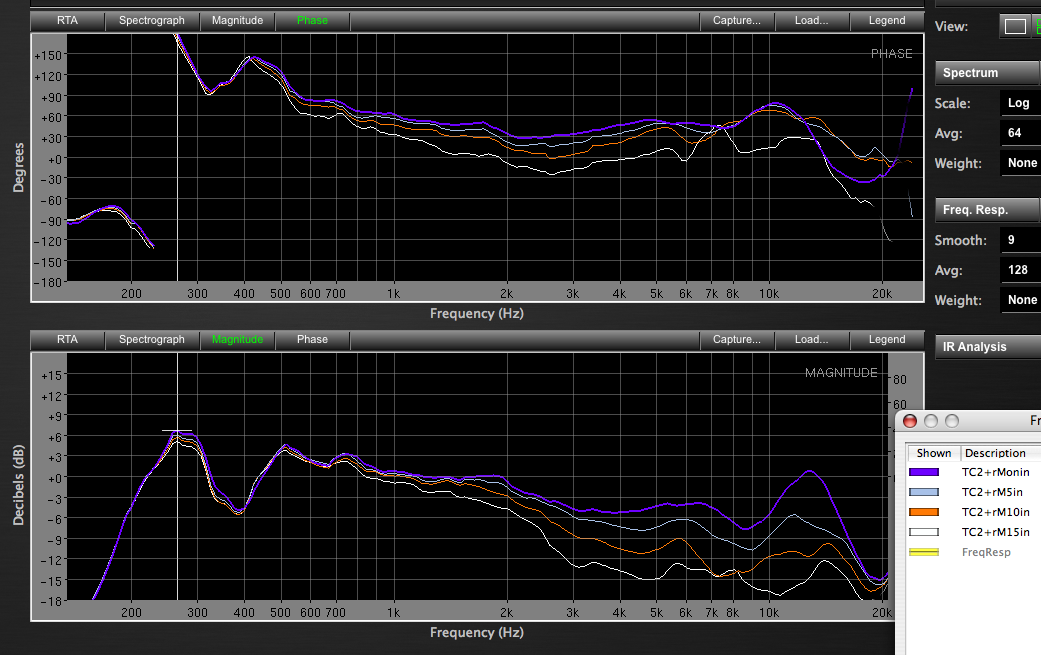
Nice work! Did you end up using a foam or felt damping ring as Bushmeister suggested? Was the main difference getting the throat enlarged? So it seems that driver cone dia and horn throat dia are a critical value to match up as Bushmeister suggested earlier that the surround needs to be out of view of the throat so that the cone proper just fills the throat when viewed end-on.
Do you have some photos of the throat and driver spacer and damping?
You are actually planning on using these to drive a PA application at 120dB+ to 130dB+ - wow! That is some performance for a cheap $10 "TV speaker".
There is also an XR1464C in plastic! 18 Sound XR1464C Constant Coverage HF Horn (1.4 Throat) . Shape wise it's probably easier to mount the drivers on, but its significantly more expensive than the XT.
Back to lurking and trying to wrap my head around the compromises to juggle here. 🙂
Back to lurking and trying to wrap my head around the compromises to juggle here. 🙂
There is also an XR1464C in plastic! 18 Sound XR1464C Constant Coverage HF Horn (1.4 Throat) . Shape wise it's probably easier to mount the drivers on, but its significantly more expensive than the XT.
Back to lurking and trying to wrap my head around the compromises to juggle here. 🙂
This waveguide is much more compact at 10.5in wide. However is only 7.1 in deep which precludes use of 8in drivers and would require 6.5in drivers, maybe four of them one on each wall. Also, the reduced length will reduce the bottom horn gain ability to boost the sensitivity of the full range driver.
This page shows all of eighteensound's current horns
Constant Directivity High Frequency Horns
when you see them next to each other it is much easier to see the differences and the numbering scheme tends to make more sense XR for square XT for elliptical
This eminence horn with a 2" throat also looks interesting for full range use
https://www.parts-express.com/eminence-h2ea-2-cast-aluminum-exponential-horn-60x40-4-bolt--290-551
It loads to 700Hz and has less vertical coverage to reduce floor and ceiling reflections. Harder to fit big woofers on the side but the sides are flatter which would mean mounting is easier than on the elliptical horns. Would make a nice horn loaded FAST as there would be less CTC distance.
Constant Directivity High Frequency Horns
when you see them next to each other it is much easier to see the differences and the numbering scheme tends to make more sense XR for square XT for elliptical
This eminence horn with a 2" throat also looks interesting for full range use
https://www.parts-express.com/eminence-h2ea-2-cast-aluminum-exponential-horn-60x40-4-bolt--290-551
It loads to 700Hz and has less vertical coverage to reduce floor and ceiling reflections. Harder to fit big woofers on the side but the sides are flatter which would mean mounting is easier than on the elliptical horns. Would make a nice horn loaded FAST as there would be less CTC distance.
That Eminence with 2in throat looks interesting for use with a slightly larger driver. The length is only 6.1in which precludes even 6.5in woofers. It's also aluminum which would make cutting holes interesting. Thanks for bringing it up though.
3D printed throat adapter
I was thinking that all the hand labor involved in making a smooth throat contour that matches the driver bezel and mounting spacer can be made with a single 3D printed adapter that precisely holds the driver bezel flange and forms the extra lip and surround standoff height plus it can contain the large smooth radiused curve that gradual progresses from the driver surround to the existing throat geometry. The existing horn could then be left untouched from files, tools, etc. the 3D printed adapter would be pretty close to the final shape however could be easily sanded and smoothed manually for a shiny finish if that is critical.
The adapter will add maybe an extra 0.5in or so to horn's design length but I don't think that's a big deal.
Does this idea sound good?
I was thinking that all the hand labor involved in making a smooth throat contour that matches the driver bezel and mounting spacer can be made with a single 3D printed adapter that precisely holds the driver bezel flange and forms the extra lip and surround standoff height plus it can contain the large smooth radiused curve that gradual progresses from the driver surround to the existing throat geometry. The existing horn could then be left untouched from files, tools, etc. the 3D printed adapter would be pretty close to the final shape however could be easily sanded and smoothed manually for a shiny finish if that is critical.
The adapter will add maybe an extra 0.5in or so to horn's design length but I don't think that's a big deal.
Does this idea sound good?
.....Does this idea sound good?
I'm just a no experienced amateur in this area but is it good to shrink diameter and then widen it again, seems it worked for weltersys expanding the 2" throat to 2.5" to adapt TC9FD so in general we wish commercial horns with more entrance diameter would be available.
Regarding 3D print and expanding adapter you could try print a expanding adapter for SB65 that sits in Trynergy 2" square entrance. Make it so cones diameter in the forties mm area continue smooth to 2", also in start of squarer throat mayby corners could be rounded a bit with some filling material so adapter is round and transition to squarer is in throat.
Regarding woofer/mid injection ports and your various sims to find alternative woofers it seems you often like a bit more low reach, speculate if it will work add a bit of Mms to cone would do the job and excursion will still be inside specs.
Last edited:
Byrtt,
Great suggestion to try this out on SB65 and uTrynergy. My fear is that a square throat even with an adapter will never be as good as a true round throat for a round driver. I can give it a try but the Faital Pro LTH142 60x50 elliptical tractrix horn has been ordered and should be here in a few days. I ordered a couple of Dayton DC200-8's to go with it. Great suggestion of adding mms to cone to bring fs lower and get more bottom end extension. In that sense maybe that's all the 6FE100 needed? Certainly mms can be boosted in sims to see what happens. Thanks for the great suggestion.
I have two drivers I want to try: certainly the SB65WBAC25-4 that Bushmeister has shown to work well, but there is also the Fountek FR58EX which has the perfect size aluminum cone and rubber surround and a powerful Nd motor with a lower Qts than the SB65. Incidentally, both drivers were kindly provided to me by you! Thanks! 🙂
Great suggestion to try this out on SB65 and uTrynergy. My fear is that a square throat even with an adapter will never be as good as a true round throat for a round driver. I can give it a try but the Faital Pro LTH142 60x50 elliptical tractrix horn has been ordered and should be here in a few days. I ordered a couple of Dayton DC200-8's to go with it. Great suggestion of adding mms to cone to bring fs lower and get more bottom end extension. In that sense maybe that's all the 6FE100 needed? Certainly mms can be boosted in sims to see what happens. Thanks for the great suggestion.
An externally hosted image should be here but it was not working when we last tested it.
I have two drivers I want to try: certainly the SB65WBAC25-4 that Bushmeister has shown to work well, but there is also the Fountek FR58EX which has the perfect size aluminum cone and rubber surround and a powerful Nd motor with a lower Qts than the SB65. Incidentally, both drivers were kindly provided to me by you! Thanks! 🙂
Last edited:
Re' 3D printing
I think that is a great idea if you have a 3D printer. You could include an inverse cone phase/volume plug structure to minimize Vtc. If you get a bandpass chamber effect from a throat adapter, it could kill your high end.
Take another look at the 3FE25's we talked about" 3" 91db 20W. I just put calipers on one and its only 2.2" between inside edges of the rubber half roll surround. That should be only marginally more difficult to transition than a 2" driver. the 3FE25 IS a full range driver.
The SEOS profiles seem like a dead end for this idea of using a full range driver at the throat as they aren't deep enough for a decent woofer on the sides. They do have nice flat sides for small midwoofers for implementing a conventional synergy with a CD at the throat.
Of course if cost were no object you could consider the SEOS24, which can be had with either a 1.4" or 2" throat and is deep enough for a real woofer. I'd much rather pay $25 for a full range driver than $500+ for a coaxial CD, if it worked.
But is a constant directivity profile appropriate? These have a 6 db roll off starting at a few khz that has to be equalized out. A conventional CD has excess sensitivity to give up to equalization but a full range driver does not.
Speaking of profiles, I don't think an exponential profile (e.g. the Eminence 2" that was suggested) will work. An exponential horn has very low output below cutoff and has a mass load corner to contend with at the high end. It may be that the tractrix profile is the only one that will work well but I don't know enough about it to say.
edit: now that I think about it, I think the profile tradeoff is between aconstant directivity response, which requires HF equalization and a flat response, which comes with narrowing of directivity at HF. e.g. the beaming of LeCleach and perhaps also Tractrix
I think that is a great idea if you have a 3D printer. You could include an inverse cone phase/volume plug structure to minimize Vtc. If you get a bandpass chamber effect from a throat adapter, it could kill your high end.
Take another look at the 3FE25's we talked about" 3" 91db 20W. I just put calipers on one and its only 2.2" between inside edges of the rubber half roll surround. That should be only marginally more difficult to transition than a 2" driver. the 3FE25 IS a full range driver.
The SEOS profiles seem like a dead end for this idea of using a full range driver at the throat as they aren't deep enough for a decent woofer on the sides. They do have nice flat sides for small midwoofers for implementing a conventional synergy with a CD at the throat.
Of course if cost were no object you could consider the SEOS24, which can be had with either a 1.4" or 2" throat and is deep enough for a real woofer. I'd much rather pay $25 for a full range driver than $500+ for a coaxial CD, if it worked.
But is a constant directivity profile appropriate? These have a 6 db roll off starting at a few khz that has to be equalized out. A conventional CD has excess sensitivity to give up to equalization but a full range driver does not.
Speaking of profiles, I don't think an exponential profile (e.g. the Eminence 2" that was suggested) will work. An exponential horn has very low output below cutoff and has a mass load corner to contend with at the high end. It may be that the tractrix profile is the only one that will work well but I don't know enough about it to say.
edit: now that I think about it, I think the profile tradeoff is between aconstant directivity response, which requires HF equalization and a flat response, which comes with narrowing of directivity at HF. e.g. the beaming of LeCleach and perhaps also Tractrix
Last edited:
I was also thinking of adding a phase plug but fear that would increase compression ratio which full range low BL drivers don't like. Also it may create bandpass chamber and make HF disappear. Easy to try but given success of Bushmeister's smooth profile but open throat concept - I think I am going try that first.
The tractrix and the elliptical narrow throat used by 18Sound on XT1464 so appear similar. 18Sound does not call theirs a tractrix bit it does seem to give horn loaded gain down to 500Hz. The tractrix profile does indeed give horn gain down low. My uTrynergy at 11in is a 350Hz horn. The narrow throat and longer initial channel expansion seems key to providing the efficiency needed by these full range drivers.
I have tried the 3FE22 in 4r, 8r, and 16r (a lower Qts version of 3FE25). It works quite well with great high sensitivity. However it has a nasty ring around 12k that I can't seem to get rid of. It shows up as a peak/notch combo and a long many cycle oscillation in the impulse response.
It is quite a bit bigger than the SB65 and I believe is more suited to a 2.0 to 2.5in dia throat. 1.4in may constrict too much and force a bandpass behavior that will kill HF's.
The 3D printer is revolutionizing how complex we can make DIY horn geometries. It is good for small parts like throat adapters. Even waveguides for a 1in dome tweeter are a bit too big to print cost effectively.
The tractrix and the elliptical narrow throat used by 18Sound on XT1464 so appear similar. 18Sound does not call theirs a tractrix bit it does seem to give horn loaded gain down to 500Hz. The tractrix profile does indeed give horn gain down low. My uTrynergy at 11in is a 350Hz horn. The narrow throat and longer initial channel expansion seems key to providing the efficiency needed by these full range drivers.
I have tried the 3FE22 in 4r, 8r, and 16r (a lower Qts version of 3FE25). It works quite well with great high sensitivity. However it has a nasty ring around 12k that I can't seem to get rid of. It shows up as a peak/notch combo and a long many cycle oscillation in the impulse response.
It is quite a bit bigger than the SB65 and I believe is more suited to a 2.0 to 2.5in dia throat. 1.4in may constrict too much and force a bandpass behavior that will kill HF's.
The 3D printer is revolutionizing how complex we can make DIY horn geometries. It is good for small parts like throat adapters. Even waveguides for a 1in dome tweeter are a bit too big to print cost effectively.
I'd still love to see someone do a JMLC Synergy, done like in this thread with full range and helper woofers. I bet the JMLC type horns come in various throat sizes. No idea how active that firm in Poland is though that was making all kinds and shapes.
I don't completely subscribe to the smaller form-factor is better yet. I bet the bigger horns have advantages. Maybe put a 3 woofer B&O 90 inspired bottom on it to complete a 3 way with ability to run low, deep and controlled.
I don't completely subscribe to the smaller form-factor is better yet. I bet the bigger horns have advantages. Maybe put a 3 woofer B&O 90 inspired bottom on it to complete a 3 way with ability to run low, deep and controlled.
JMLC horn is interesting of course. They are very pricey though in the $400 price range so not great for experiments with cutting holes in them. They should have excellent gain for the full range though.
I have a pair of 12in pro woofers I can use as a start. More likely just use my bass horn with 98dB sensitivity and 0.3% THD at 50Hz and 100dB.
I have a pair of 12in pro woofers I can use as a start. More likely just use my bass horn with 98dB sensitivity and 0.3% THD at 50Hz and 100dB.
1)No, I cut the horn length down to the point where the entrance was 2.5" instead of 2". As posted in #249, the felt ring in the 2" throat made the 5.9kHz notch much worse, and expanding the throat to 2.5" (the diameter of the TC9 cone) would leave hardly any room for a felt ring. A 1/2" radius on the driver side of the throat actually made the response just a tiny bit rougher.Nice work!
1)Did you end up using a foam or felt damping ring as Bushmeister suggested? Was the main difference getting the throat enlarged?
2)So it seems that driver cone dia and horn throat dia are a critical value to match up as Bushmeister suggested earlier that the surround needs to be out of view of the throat so that the cone proper just fills the throat when viewed end-on.
3)Do you have some photos of the throat and driver spacer and damping?
4)You are actually planning on using these to drive a PA application at 120dB+ to 130dB+ - wow! That is some performance for a cheap $10 "TV speaker".
2) Yes. The unfortunate consequence is the larger throat looses horn loading, dropping sensitivity by as much as 5 dB below 4kHz and exposes other peaks and dips caused by the wider beaming "piston" exposed. The resultant 8.2 kHz dip is nearly as deep as the 5.9 kHz dip, so probably won't be cutting any more horns down, which will save a lot of work on this project using 8 horns configured as four two-cell units, normally arrayed as a 45x45 quad-cell either side of stage.
The 45 x 20 coverage of a two-cell also happens to be wide enough to cover my couch at 10 feet, will be giving them a try for that application too, though the 28" depth is not going to allow them to stay long term :^(.
3)The photos below show the throat 2" and 2.5" throat comparison, and the horns side by side. The 2.5" throat horn has a shorter secondary expansion (termite problem...) which may have contributed to some of the gain loss, will make the horn the same length and re-test, though I don't think it will make much difference.
It is interesting that the TC9 loaded Maltese horn actually has smoother response than the driver as a front loaded unit.
Art
Attachments
Last edited:
Weltersys,
Those horns really did get cut down to achieve the matching throat! Ouch! Can you explain the differences in the plots? What are we looking at? Are the smoother lower graphs the cut down ones with a rounded throat?
Also, I don't know what you mean by this:
Isn't the TC9 a front loaded driver in the Maltese?
Thanks for the photos of closeups of the throat region and the rear chamber box.
Those horns really did get cut down to achieve the matching throat! Ouch! Can you explain the differences in the plots? What are we looking at? Are the smoother lower graphs the cut down ones with a rounded throat?
Also, I don't know what you mean by this:
It is interesting that the TC9 loaded Maltese horn actually has smoother response than the driver as a front loaded unit.
Isn't the TC9 a front loaded driver in the Maltese?
Thanks for the photos of closeups of the throat region and the rear chamber box.
- Home
- Loudspeakers
- Multi-Way
- A Bookshelf Multi-Way Point-Source Horn
